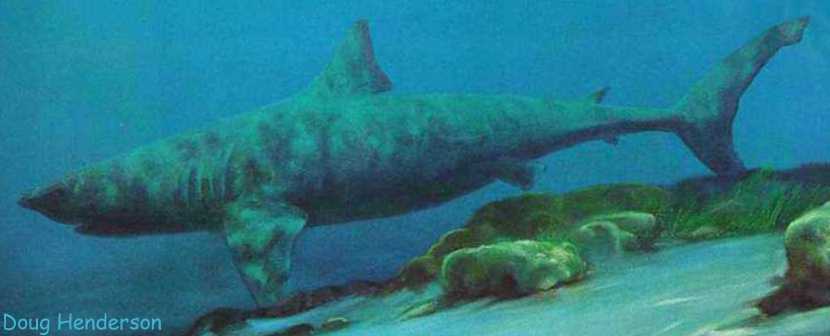

Cretoxyrhina mantelli by Doug Henderson. Copyright © Doug Henderson; used with permission of Doug Henderson
A GIANT GINSU SHARK
(Cretoxyrhina mantelli Agassiz)
FROM THE LATE CRETACEOUS CHALK OF KANSAS
Copyright © 2002-2010 by Mike Everhart
Webpage created May 26, 2002; last updated 05/06/2010
Cretoxyrhina mantelli Agassiz 1843: A large lamniform shark found worldwide from Turonian into Campanian time during the Late Cretaceous. Much the same size as a modern Great White (but not closely related), the Ginsu shark reached lengths of more than 6 meters before becoming extinct about 82 million years ago.
| In 1891, Charles H. Sternberg found
the remains of a very large Cretoxyrhina. He recounts the discovery in his 1907 paper in the Transactions of the Kansas Academy of Science: "The same museum possesses an unusual specimen of an ancient shark, Oxyrhina mantelli, found on Hackberry creek, Gove county, Kansas, in 1890. The remarkable thing about this specimen is that the vertebral column, though of cartilaginous material, was almost complete, and that the large number of 250 teeth were in position. When Chas. R. Eastman, of Harvard, described this specimen, it proved so complete as to destroy nearly thirty synonyms used to name the animal, and derived from many teeth found at various former times." On page 113-114 of his 1909 "Life of a Fossil Hunter," he describes the discovery of a 20 [foot?] shark [Cretoxyrhina] from the chalk [probably in Gove Co., south of Park, KS]. The specimen was nearly complete, with "over 250 teeth".... Quoting Sternberg, "This is the first time and, I believe, the only time that so complete a specimen of this ancient shark has been discovered. The column and other solid parts were composed of cartilaginous matter which usually decays so easily that is rarely petrified. I suppose my specimen was old at the time of its death, and bony matter had been deposited in the cartilage. It is not very likely that such a specimen will ever be duplicated. Dr. Eastman's [1895?] study of this skeleton enabled him to make synonyms of many species which had been named from teeth alone." According to Sternberg, "the most complete skeleton of the Cretaceous shark, Oxyrhina mantelli [Cretoxyrhina mantelli] Agassiz ever discovered in any formation" was sold to the "Ludwig-Maximilian University of Munich." ... and again in the Transactions of 1911, he mentions the same discovery, and then describes a new find by his son, George: "In 1891, while employed by the Munich Museum, I discovered the first and most complete skeleton known of the shark Oxyrhina mantelli in the same vicinity. This was made the subject of Dr. C. R. Eastman's inaugural address delivered before the Ludwig-Maximilian University of Munich for his Ph.D. degree." "The crowning discovery of our work here was the discovery by George Sternberg of a nearly complete skeleton of a great shark, Lamna. .... The specimen we collected on the south side of Hackberry creek, South of Banner post office, in Trego county, includes the plates of the mouth holding the teeth, of which some 150 are in sight, and the entire column of flattened disk-like vertebrę to within five feet of the end of the tail. The total length is about twenty feet of the preserved head and column. I think this will prove one of the greatest scientific discoveries of the year, because the sharks are cartilagenous [sic], and consequently their skeletons are not preserved. But in the two cases mentioned enough bone was deposited to preserve the greater part of the skeleton." Unfortunately, the specimen in the Munich museum was destroyed in World War II. The second specimen is in the University of Kansas Museum of Natural History: "The Portheus, now swimming for life, was the foci of the sharks that were coming to the attack from all directions. One would dive under the fish, and receive, for his pains, a stroke from his powerful tail that would put him out of commission; another would receive a thrust from the sword-like ray of the front fin. Undaunted, others hurried up like a pack of wolves on a wounded deer. Though many were wounded in the fray, our hero fish at last succumbed to numbers, who gashed his body with their lance-like teeth, and the water was tinged with his life blood, until, weakened and overpowered, he gradually ceased struggling. The sharks gathered to the feast. One, however, was so badly wounded by the Portheus, that he went to the oozy bottom with him. I have preserved in the Museum of the University of Kansas a shark twenty-five feet long, and mingled with his remains were the bones of a Portheus, the evident result of such a combat … “ Excerpted from Charles H. Sternberg's "Hunting Dinosaurs on the Red Deer River, Alberta, Canada" (1917, p. 162). While the passage from C H. Sternberg's book is fiction, it is based on the discovery of the remains (KUVP 247) of a large Cretoxyrhina mantelli (Ginsu shark) that also contains the scattered bones of a large Xiphactinus as its last meal. The specimen is on exhibit in the University of Kansas Museum of Natural History in Lawrence, Kansas. |
A hundred or so years later....
It was the last week of April and time for the annual field trip for the New Jersey Paleontological Society. They had scheduled Kansas as the first stop of their 2002 "Frantic Fossil Frenzy" and met me at the Sternberg Museum on Friday afternoon. A light drizzle was falling but we were optimistically looking forward to a couple of good days in the chalk. After dinner, we drove about 45 minutes west to Quinter and stayed at the Q-Motel. More rain arrived in the middle of the night and it was still cloudy when we went to breakfast on Saturday morning. The motel operator, Mr. Graham, said that they hadn't gotten much rain overnight, but I was still nervous about the 20+ miles of dirt road we would have to travel to get to the site where we had permission to hunt for fossils.
This year we were going to a new area in southeastern Gove County where I hadn't taken yet the club. We finished breakfast and got everything loaded for the hopefully brief trip to the chalk. At first the road was damp but still hard packed and passable. Just south of the turn-off to Castle Rock, however, things changed for the worse. The next four miles of dirt road had recently been rebuilt by the County. In western Kansas, this means digging the sand, gravel and dirt out of the ditches and putting it back on top of the road bed. This is fine in dry weather, but after a gentle, soaking rain, a new road gets "greasy". We had to slow down to less than 15 mph and concentrate on keeping the vehicles pointed in the right direction while going down the center of the road. Sliding off into the deep ditches on either side was not an option. After what seemed like an hour of white-knuckle driving, we made it back to a hard packed road and resumed a more normal speed.
By about 9:00 AM when we arrived at the site, the clouds had cleared off and the sun was out. We parked on the west side of a shallow valley, looking to the east at a lot of exposed chalk. The weather continued to change and pretty soon the wind was blowing like mad out of the west. The weather channel had predicted strong winds, with gusts to 40 mph, and this time the forecast was correct. With the wind blowing like it was, everyone naturally headed to the east, keeping the wind at their back. The wind in our eyes and ears made it difficult to concentrate on finding anything and no one was finding much. Within the first half hour or so, however, I had picked up 3 medium-sized Cretoxyrhina teeth, weathered but otherwise pretty nice. Since two of the teeth came from very close together, I was down on my hands and knees looking to see if I could find more. Even though there were no more sharks teeth, I did find the proximal end of the coracoid bone of an Ichthyornis dispar, my first find of this species and only my second bird fossil from the chalk (my other was a much larger fragment of a leg bone of Hesperornis). Ichthyornis is about the size of a pigeon or seagull, so you can imagine the size of a single bone fragment! About the only way of finding such things on the shell littered surface of the chalk was to get down on your hands and knees. When I found nothing else, I bagged the little piece of bone and kept walking to the east.
After scouting the eroded yellow chalk along the east side of the canyon, and finding little or nothing, I decided to head back to the middle of the valley and prospect in the lower, and somewhat older, gray chalk flats. Most of the rest of the group were still on the east side and it was getting a bit crowded.
We were all carrying walkie-talkie radios to stay in touch and to
brag if we found something, but there had been very little traffic on the air that
morning. Just as I started to walk up a small rise, Fred called over the radio to say he'd
found some mosasaur remains. As I turned out of the wind to talk to him, I
looked down and I noticed a funny looking, rust-orange
lump laying in a small gully. When I looked closer, I saw about 6 LARGE Cretoxyrhina mantelli teeth
coming out of the side of the gully above the lump. Then I noticed the bits and pieces of
preserved cartilage laying around and several other shark teeth that were visible in the
gully. I knew immediately that I was looking at the remains of a large shark, and realized
that there was a good chance it was fairly complete. About that point, I was also
finding words difficult to come by and told Fred he'd have to deal with the mosasaur
himself... I had a big shark. From the size of the teeth, I could tell that it was larger than those of the
nicely preserved specimen in the Sternberg Museum (FHSM VP-2187). Beyond,
that, I could just guess at what else might be there.
I started collecting float that had washed down the little gully and out into the flat
(Eventually, we would screen the out wash and find teeth as far as twenty feet away). The
narrow gully was cutting across the back of the head and doing its best to decapitate the
shark. The rust-orange chunk that I saw first turned out to be the three anterior-most
vertebrae. After I had finished my initial search, I walked back up the hill to my
van, using the time to collect my thoughts and figure out what to do next. When I got to
the van, I called my wife, Pam, on my cell phone and let her know about my good fortune.
Usually she won't allow me to find anything "good" when she's not along, but she
apparently had relented this time. A large shark like this had been on our 'wish
list' for years.
Luckily, there was an oil field road close by and I was able to drive the van to within 20 feet of the specimen on the return trip. Then I got my camera out and started taking pictures. By that time, some of the NJPS people were gathering and looking at the remains. Everyone, including myself, was in awe at what we could see. It was a huge shark, certainly a Cretaceous "JAWS". Then I got out the field map, plotted the location and checked it against the GPS data.
In a classic moment of "field paleontology meets the 21st Century", I walked back up the hill a ways to get better reception on my cell phone and called Kenshu Shimada in Chicago. Dr. Shimada (now at DePaul University) has studied Cretoxyrhina mantelli extensively and I wanted his advice on what to look for as we uncovered the remains of this huge shark. He told me that it was a "once in twenty year discovery" and I replied that if it was, I was long overdue! There are a limited number of remains of large sharks known from the Smoky Hill Chalk and Kenshu has studied most of them.
After the others went off in search of their own 'big sharks', Tom Caggiano stayed with me to help uncover the remains. Over the next several hours, he did most of the grunt work, literally removing several tons of overburden (Thanks, Tom! Yeah, I know I would have done the same for you, but thanks anyway!) while I started defining the extent of the remains. It looked like there would be at most 18 inches of chalk over the specimen, if it had gone straight to the south, but it didn't. Murphy is alive and well in paleontology. Unfortunately, the vertebral column turned to the east and came out of the slope.... the last several feet of the tail were long gone. When we initially cleared the remains, we found that we had the front 16 feet of a 20+ foot shark.
I was worried that a surprise Kansas thunderstorm could come up over night and further damage the remains, so late in the day, we jacketed and removed the head of the shark. The jacket was awkward and the chalk under it was very shaley. For some reason, the plaster didn't dry very fast and we had to wait longer than I normally would expect. I was concerned about the "moment of truth" when we rolled the jacket because we could loose the skull if everything didn't stay put. As it turned out, about half of the chalk fell out as we turned the jacket over, but the skull and supporting chalk stayed put. After loading the jacket into my van, we covered the rest of the body with plastic and dug drainage ditches around it, just in case.
The next day was as nice a Spring day as you could ask for in Kansas, warm, sunny and no wind. I removed the protective cover over the shark and started clearing additional chalk down to the level of the preserved material. Unlike a dig on something with real bones, such as a mosasaur, the shark did not have well defined areas of preserved elements. Much of the remains consisted of a thin layer of skin denticles, with 'lumps' thrown in here and there that probably represented fin elements and possibly stomach contents. I didn't want to dig too deeply and damage any of the material, and quickly concluded that the specimen needed to be picked up in one large jacket. There was not much else I could do that day except to cover the remains and make arrangements to return with more help, equipment and supplies.
After a complicated but successful recovery, the plaster frame holding the body of the shark arrived at the Sternberg Museum three weeks later. The newly assigned specimen number is FHSM VP-14010.
Stratigraphy: The shark remains were located in the lower 1/4 of
the Smoky Hill Chalk Member (Niobrara Fm), below Hattin's (1982) Marker Unit 3. Age is
latest Coniacian, within the biostratigraphic zone (Stewart, 1990) of Protosphyraena
perniciosa. Other fossils found at the site included included two sets of mosasaur
remains (a set of partially digested vertebrae that had been a shark meal and another
group of vertebrae from what appeared to be a very large Clidastes), two sets of Xiphactinus
audax remains, three Protosphyraena perniciosa pectoral fins, lots of Cretoxyrhina
mantelli shed teeth, one each Ptychodus mortoni and P. martini
teeth, lots of Volviceramus grandis shells, and a rudist (Durania maxima),
all of which are consistent with the low chalk (Late Coniacian) stratigraphy.
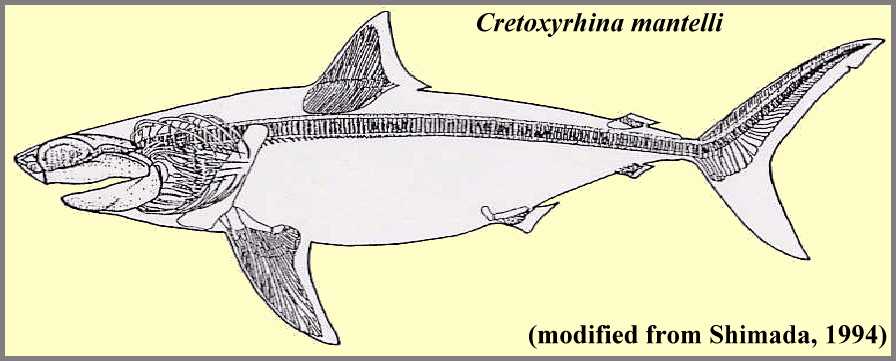
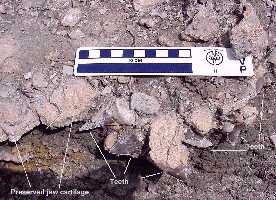 |
What I saw first....six large teeth and bits of preserved cartilage eroding out of the edge of the gully. (Scale = 10 cm) |
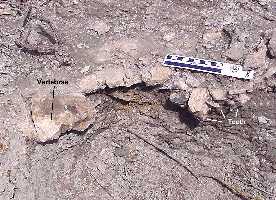 |
A view from a little further back. The object labeled vertebrae is the "rust-orange lump" that I saw in the gully as replaced in its original position.. |
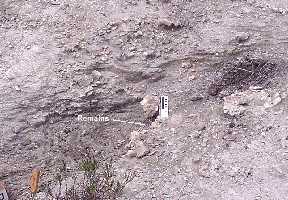 |
A view, looking to the southwest, that shows where the gully was beginning to cut across the head of the shark. |
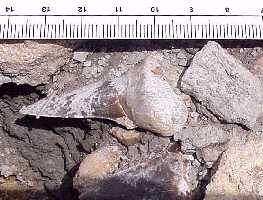 |
A close-up of one of the larger, anterior teeth still attached to the remains of the skull. The vertical height of some teeth was about 55 mm. |
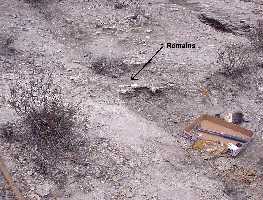 |
A shot taken from another angle, looking to the northwest. There were several small bushes in the area whose roots had invaded the remains. This will make the preparation of the specimen a bit more difficult. |
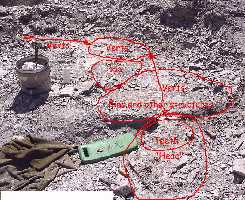 |
This picture was taken later in the first day of the dig, looking southwest, before the head was jacketed and removed. The red lines indicate the general areas of the shark remains as found. The first section of vertebrae is continuous for about 5 feet and includes at least 38 vertebrae. Then there is a section where the vertebrae are dis-articulated for a space of 4 feet. In the remaining 5 feet of the specimen, the vertebrae are generally articulated. |
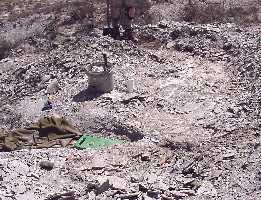 |
Another view of the entire site, looking to the southeast. The remains curved in a rough 'C' shape and came out of the chalk about where Tom Caggiano is standing. The vertebrae of the last 4-6 feet of the tail were apparently lost over a period of many years to erosion and weathering. |
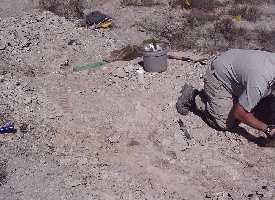 |
It's really difficult to get good pictures of paleontologists at work because they are usually in a "head-down, butt-up" position. Here, most of Tom Caggiano is shown working on the "tail end" of the remains, trying to figure out what was shark and what was dirt. The head of the shark is at the upper left corner of the picture. |
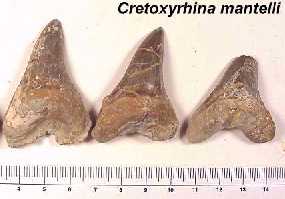 |
This picture shows several of the large anterior teeth that were found in the wash below the specimen. |
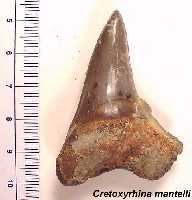 |
One of the larger anterior teeth. Not counting the tiny symphysial teeth located where the halves of the jaws come together, Cretoxyrhina has 17 teeth in each half of the upper jaw, and 18 in each half of the lower jaw. Since there are up to seven teeth in each tooth row, there may be as many as 490 teeth in a specimen. Not all of these will be completely formed, however, and many will consist of an incomplete tooth tip. |
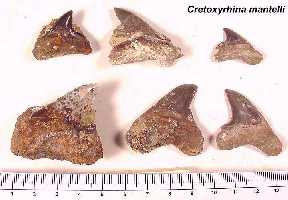 |
Several of the teeth from further back in the jaw. The largest teeth are in the anterior portions of the jaw. |
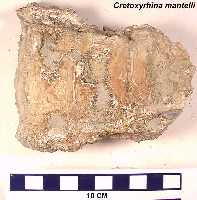 |
The large, rust-orange lump (three anterior-most vertebrae) found in the gully. Note that there are several teeth included with this piece. |
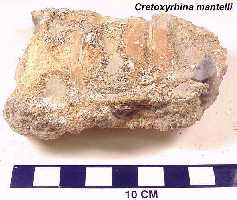 |
The bottom side of the piece containing the anterior-most vertebrae. Note the large tooth protruding upward from the right side. |
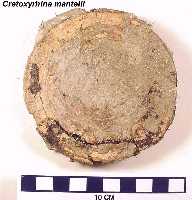 |
One of several large vertebra that were found laying loose in the center of the remains. This vertebra is is 95 mm - almost 4 inches! in diameter. |
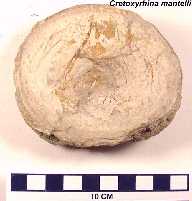 |
One the last vertebra found with the specimen. Even though these had eroded out about 14 feet from the back of the head, they were still 3 inches in diameter. In Cretoxyrhina and other sharks, the vertebrae get smaller and smaller as they get closer to the end of the tail. |
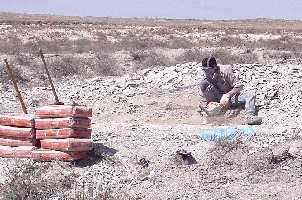 |
The body of the shark rested on chalk that was thinly layered and fractured. In order to get the body of the shark in one piece, we had to use a chain saw to cut a trench around the fossil. Here Kenneth Jenkins, of Ellis, KS., is making the deep cut on the uphill side of the remains. |
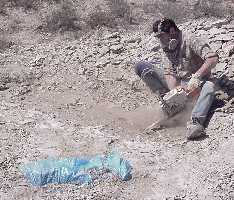 |
The carbide tipped blade on Ken's Stihl chainsaw made quick work of the soft chalk, while generating a lot of dust. The big advantage to this method, besides being fairly quick, is that it does not disturb the fossil. In the case of this shark, that was the number one priority. |
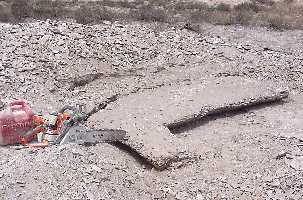 |
Once the cuts were made, the loose chalk was removed. This left the block of chalk containing the fossil standing free on a pedestal. Rebar was driven under the block to contain the material and a combination of rebar and wire screen was used as reinforcement in the space around and under the fossil that would become an enclosing frame. |
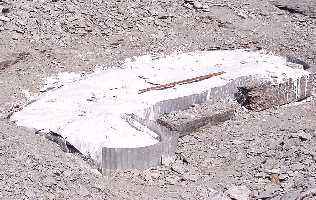 |
Finally, the last of 750 pounds of plaster was poured. The plaster set up fairly quickly but took several days to dry to full strength because of the thickness of the pour. |
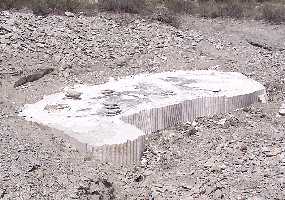 |
This view, looking to the northwest, shows the steel reinforced, plaster frame that was placed around the body of the shark to stabilize the skeletal remains. The recovery was complicated by the fact that the chalk under the shark was in half-inch layers that tended to break apart easily. Ken field-engineered this solution to a very difficult problem. The block was then rolled on to a trailer for transport to the museum. |
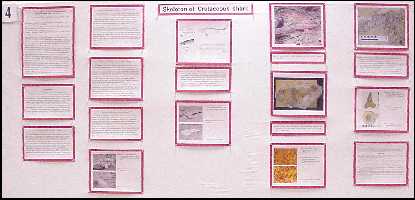 |
ABSTRACT OF THE POSTER PRESENTED AT THE 2003 SOCIETY OF VERTEBRATE PALEONTOLOGY MEETING IN ST. PAUL, MN |
| Corrado, C. A., D. A. Wilhelm, K. Shimada, and M. J. Everhart. 2003. A new skeleton of the Late Cretaceous lamniform shark, Cretoxyrhina mantelli, from western Kansas. Journal of Vertebrate Paleontology, Volume 23 (Supplement to Number 3): 43A.Cretoxyrhina mantelli (Agassiz) is a large Cretaceous lamniform shark that could have resembled the modern great white shark, Carcharodon carcharias (Linnaeus) in body size, body shape, and life style. In April of 2002, a new skeleton of Cretoxyrhina mantelli, was recovered from the Smoky Hill Chalk in southeastern Gove County, Kansas. The skeletal elements are mostly articulated and extended over a 5 m by 2 m area. Although the posterior portion of the vertebral column is missing due to weathering, the specimen, still largely unprepared, preserves much of the skeleton. The anterior portion of the skeleton is heavily weathered but does include parts of the skull and jaws. Much of the lower dentition is covered by cartilaginous elements, whereas the anterior half of the upper dentition is well exposed. The upper dentition exhibits a typical lamnoid tooth pattern with at least one row of symphysial teeth, two rows of anterior teeth, and several rows of post-anterior teeth including intermediate teeth. The crown height (= maximum vertical enameloid height) of the tallest tooth (one of the anterior teeth) is 43.5 mm, and the diameter of the largest vertebrae measures 95 mm. Calculations suggest that these dental and vertebral measurements are about 9% larger than those in the most complete C. mantelli skeleton known (FHSM VP-2187, which measures 5 m TL), indicating that FHSM VP-14010 probably had a TL of at least 5.4-5.5 m. |
Other webpages about Cretoxyrhina mantelli:
One day in the Western Interior Sea
Cretoxyrhina mantelli - The Ginsu Shark
Late Cretaceous sharks: Cretoxyrhina and Squalicorax
Parts is parts and pieces is pieces
Suggested references:
Cappetta, H. and Case, G. R., 1987. Chondrichthyes II - Mesozoic and Cenozoic Elasmobranchii. Gustav Fischer Verlag, Stuttgart and New York. 193 p., 148 fig.
Corrado, C. A., D. A. Wilhelm, K. Shimada, and M. J. Everhart. 2003. A new skeleton of the Late Cretaceous lamniform shark, Cretoxyrhina mantelli, from western Kansas. Journal of Vertebrate Paleontology, Volume 23 (Supplement to Number 3): 43A.
Eastman, C. R., 1895. Bietrage Kenntniss Gattung Oxyrhina mit besonderer Berucksichtigung von Oxyrhina mantelli Agassiz. Palaeontographica 41:149-192.
Everhart, M. J., 1999. Evidence of feeding on mosasaurs by the late Cretaceous lamniform shark, Cretoxyrhina mantelli. Jour. Vert. Paleon. 17(suppl. to 3):43A-44A.
Everhart, M. J., P. A. Everhart and K. Shimada, 1995. New specimen of shark bitten mosasaur vertebrae from the Smoky Hill Chalk (upper Cretaceous) in western Kansas. Kansas Acad. Sci. Trans. 14(Abstracts):19.
Meyer, R. L. 1974. Late Cretaceous elasmobranchs from the Mississippi and East Texas embayments of the Gulf Coastal Plain. Unpublished Doctoral dissertation, Southern Methodist University, Dallas, 419 pp.
Shimada, K., 1994. Paleobiology of the Late Cretaceous shark, Cretoxyrhina mantelli (Lamniformes: Cretoxyrhinidae), from Kansas. unpub. Masters thesis. 169 pp. Fort Hays State University.
Shimada, K., 1997. Dentition of the Late Cretaceous lamniform shark, Cretoxyrhina mantelli, from the Niobrara Chalk of Kansas. Journ. Vert. Paleon. 17(2):269-279.
Shimada, K., 1997. Stratigraphic record of the Late Cretaceous lamniform shark, Cretoxyrhina mantelli (Agassiz), in Kansas. Kansas Acad. Sci. Trans. 100(3-4):139-149.
Shimada, K., 1997. Paleoecological relationships of the Late Cretaceous lamniform shark, Cretoxyrhina mantelli (Agassiz). Journ. Paleon. 71(5):926-933.
Shimada, K., 1997. Periodic marker bands in vertebral centra of the Late Cretaceous lamniform shark, Cretoxyrhina mantelli. Copeia (1):233-235.
Shimada, K. 2008. Ontogenetic parameters and life history strategies of the Late Cretaceous lamniform shark, Cretoxyrhina mantelli, based on vertebral growth increments. Journal of Vertebrate Paleontology 28(1):21-33.
Siverson, M., 1992. Biology, dental morphology and taxonomy of lamniform sharks from the Campanian of the Kristianstad Basin, Sweden, Paleontology, 35(3): 519-554.
Siverson, M., 1996. Lamniform sharks of the Mid Cretaceous Alinga Formation and Beedagong Claystone, Western Australia, Paleontology, 39(4): 813-849.
Sternberg, C. H., 1907. Some animals discovered in the fossil beds of Kansas. Kansas Academy of Science, Transactions 20:122-124.
Sternberg, C. H., 1911. In the Niobrara and Laramie Cretaceous. Kansas Academy of Science, Transactions23:70-74.
Sternberg, C. H. 1917. Hunting Dinosaurs in the Badlands of the Red Deer River, Alberta, Canada. Published by the author, San Diego, Calif., 261 pp. (References to Cretoxyrhina and Xiphactinus)
Sternberg, C. H., 1990. The life of a fossil hunter, Indiana University Press. (Originally published in 1909)
Williston, S. W. 1900. Cretaceous fishes: Selachians and Pycnodonts. University Geological Survey Kansas VI pp. 237-256, with pls.